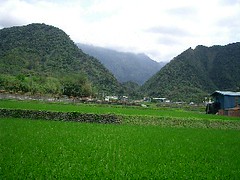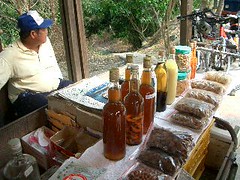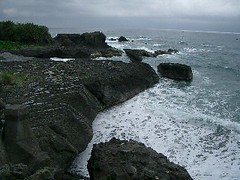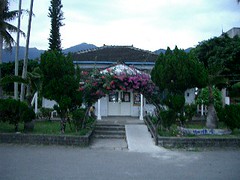Washington Post Ma interviewMichael Turton over at The View From Taiwan says he'll "be watching this one[Ma Ying Jeou's US trip] closely, as it will be an important test of the fairness and accuracy of US media."
Rank will kick things off by a review of Edward Cody's interview with Ma in the Washington Post.
Here in Taiwan, a strong majority has consistently told poll-takers that maintenance of the status quo is the wisest course, expressing unwillingness to embrace reunification but uneasiness about the possibility that a passionate quest for independence could lead to war. A dip in the island's economic growth has added another argument, raising fears that Chen's independence drive is diverting official attention from economic concerns. In casual conversations last week, residents of the capital, Taipei, repeatedly emphasized worries that Chen's priorities were out of balance.
The problem here of course is that residents of Taipei City tend to be anti-Chen because of the high proportion of mainlanders in Taipei. Foreign journalists and others consistently make the mistake of conflating views they hear in Taipei with those of the rest of Taiwan. And then they wonder why the KMT doesn't always win.
In fact, there is a fierce debate going on over Taiwan's economy. The pro-China parties say that Chen is ignoring the economy while the pro-Taiwan parties and press say that the reason Taiwan's economy is growing slowly is because Taiwan's industrial base is being hollowed out investment in China.
In spite of that investment, Taiwan's economy has been making modest but consistent gains over the past 18 months. Taiwan is also undergoing a difficult transition from a manufacturing economy to an service-oriented knowledge economy. But whoever wins the next election will have difficulties meeting expectations of fast economic growth that were created during Taiwan's boom days as it industrialzed. Those days are not going to come back no matter who is president simply because Taiwan relatively mature economy is simply not going to grow at a rate of 10 percent.
Ma, the mayor of Taipei, has the movie-star looks and sleaze-free appeal to capitalize on the new political winds, Taiwanese analysts said, provided nothing blows him off course during the next two years. Women on both sides of the Taiwan Strait especially appreciate him. Hearing that a friend was about to interview Ma, Chen Hui-ting, a 24-year-old college student, said: "Wow, that's so cool to be meeting Ma. Say hi to him for me."
Ma's supposed appeal to women and this quote are both misleading. While Ma does appeal to some segments of Taiwan's newly-minted middle class, I have often heard working class Taiwanese women (especially down south) say that he is not manly enough and that he comes off as being weak. So his appeal may not be universal.
Taiwanese tend to get excited about meeting celebrities. So just because Ms. Chen thinks it would be cool to meet Ma, it does not necessarily follow that she will vote for him. You can see this if you follow two candidates from different parties as they canvas a traditional market. There will be shouts of Dongsuan (Elected!) for both candidates and gifts of turnips (sign of good luck and prosperity) for both candidates. In other words, the warmth of a reception is no guaruntee that votes will be delivered.
But he has left nothing to chance. To broaden his appeal among Taiwan's native population -- who provide Chen his base -- Ma has been studying Taiwanese dialect and renewing ties to the man he defeated to become Nationalist chairman, Wang Jin-pyng, the parliamentary speaker and a native Taiwanese.
Calling Taiwanese a dialect is a sure sign of bias. And Ma has hardly smoothed things over with Wang, who is still smarting from the thrashing Ma gave him. This is a good example of how the personal usually trumps political principle in Taiwan. Wang could well defect in 2008 or wait in the wings for the conclsuion of a disasterous first term for Ma and then run on some kind of pro-Taiwan ticket in 2008.
The son of a Nationalist general who came from the mainland with the defeated Chiang Kai-shek in 1949, Ma has been a party activist since his student days.
The KMT didn't have party activists when MA was cronying his way up the ranks and allegedly spying on Taiwanese activists at Harvard. But Ma's 'activist days' are worth looking at partly because of his involvement in the Diaoyutai Islands movement, a touchstone for Chinese nationalism in Taiwan. One of the more telling omissions in Cody's interview is his failure to address Ma's Chinese nationalism. What many foreigners believe they are getting in Ma is a western-educated English speaking politician they can deal with and who shares or understands US interests. While Ma is genuinely committed to democracy and rule of law, he is also a fairly hardcore Chinese nationalist who will almost certainly tilt Taiwan sharply toward China and away from the US.
Despite his promise to smooth relations with China, Ma is likely to face hostile questions in Washington about why his party's legislative majority has blocked an $18.2 billion arms sale proposed by the Bush administration five years ago and pushed without success by Chen.
Ma's position, as he repeated on TV, is that Taiwan does not need and cannot afford 'unreasonable' arms purchases. At the core of Ma position is the proposition that Taiwan does not need to buy weapons from the US because he is going to defuse tensions with China by not confronting China. This is not only dangerous since the one of the few things in the outside world that China's leadership seems to understand and respect is military power, but also unpersuasive since the US is concerned that Taiwan is effectively disarming itself while China is vastly expanding its military arsenal. The arms purchases are unreasonable for Ma because as a Chinese nationalist he does not see China as a threat to Taiwan.
Ma said the Bush administration was unwise to accept Chen's decision on the unification council with only a mild reaction. U.S. and Taiwanese officials had negotiated the language carefully, leading Chen to abandon his stated intention to "abolish" the council in favor of the "ceased to function" formulation. Largely on that basis, the administration accepted Chen's contention that the status quo was not changed by his decision.
But Ma, citing his training as a lawyer, said the Chinese word Chen used in fact means "terminate," which does imply a change in the status quo. In addition, he said, no matter what the language, Chen's decision to stand up and announce the end of an official symbol of willingness to get along with China amounted to provocation.
Rank agrees with Ma analysis of the term 'zhongzhi' which means terminate and is a legal term of art. If a contract is terminated it means that it existed in the past but that it no longer exists now. By terminating the Council, Chen is admitting that the Council once existed, but it no longer exists now. In any event, it is clear that here in Taiwan, all shades of the political spectrum agree that the Council no longer exists, and Chen has pointedly refused to publicly affirm that the Council still exists as the US State Department has asked him to do.
Ma, by the way, is not admitted to the bar in Taiwan because he could not pass the notoriously difficult bar exam (less than 1 percent of candidates passed in 1970s and 1980s) although he did graduate from National Taiwan University with a degree in law. Chen, Frank Hsieh, and Su Chen-tsang, in contrast, are all admitted lawyers.
His last comment about the US's being gullible is one that I think he should have left unsaid. He tried a similar line with the obviously well-prepped interviewer in his recent BBC interview where he said that the interviewer didn't understand Taiwan's relations with China. Rather than engage in a serious discussion of ideas, Ma is showing a tendency to dismiss foreigners who disagree with him as being gullible or failing to understand the 'impenetrable' mysteries of the east. His English may be fluent, but his mind, Rank fears, is shut tight.













